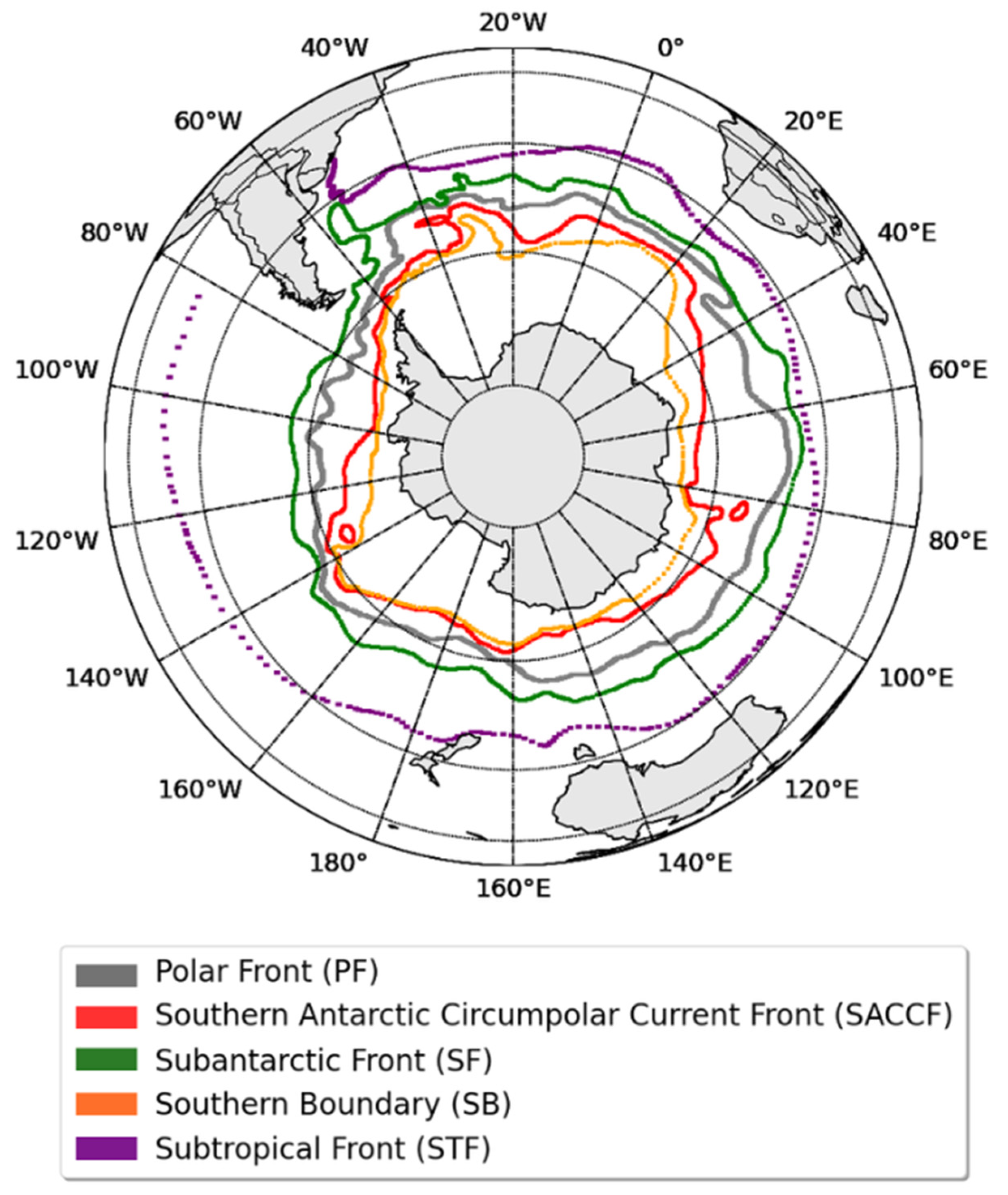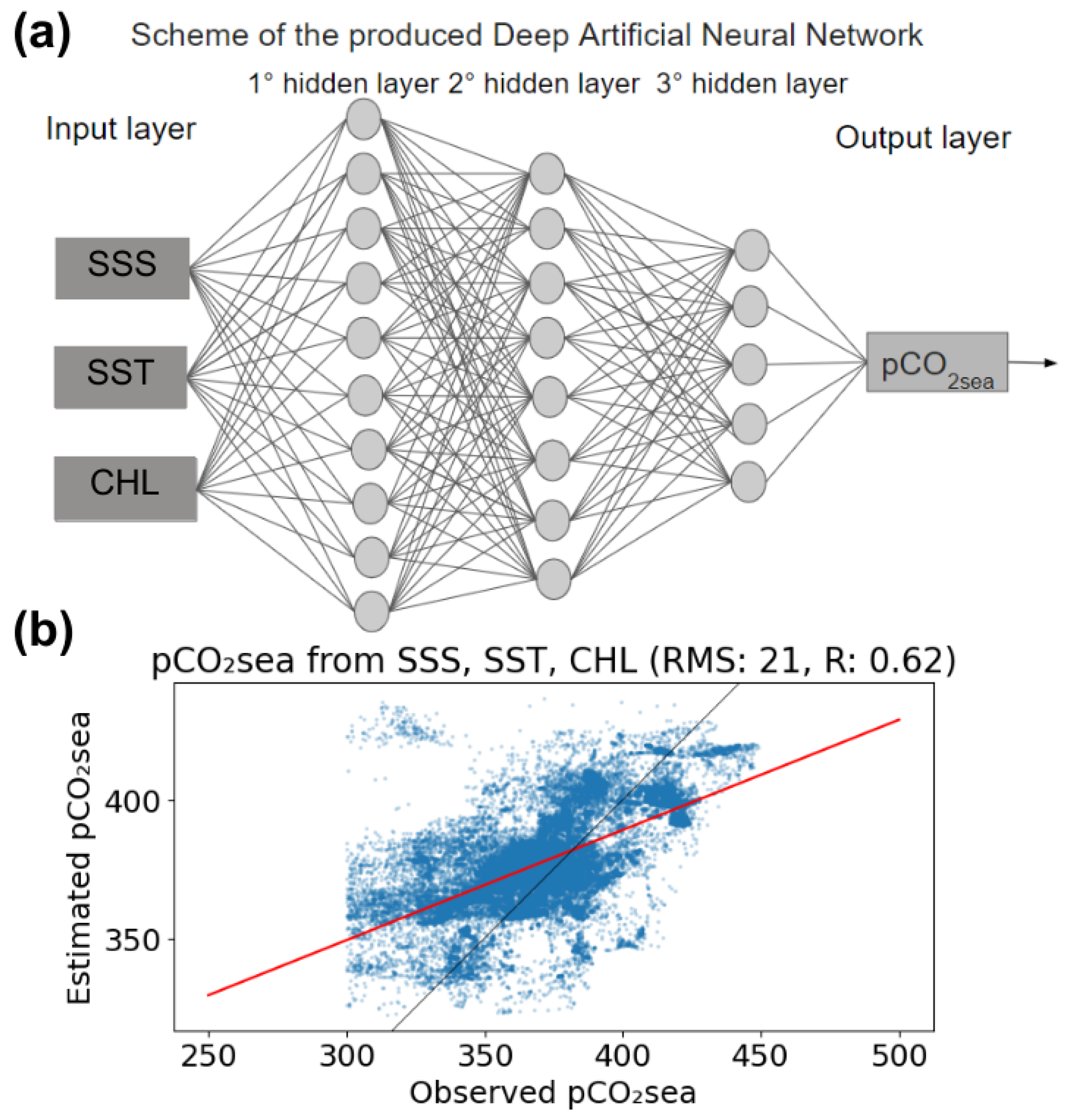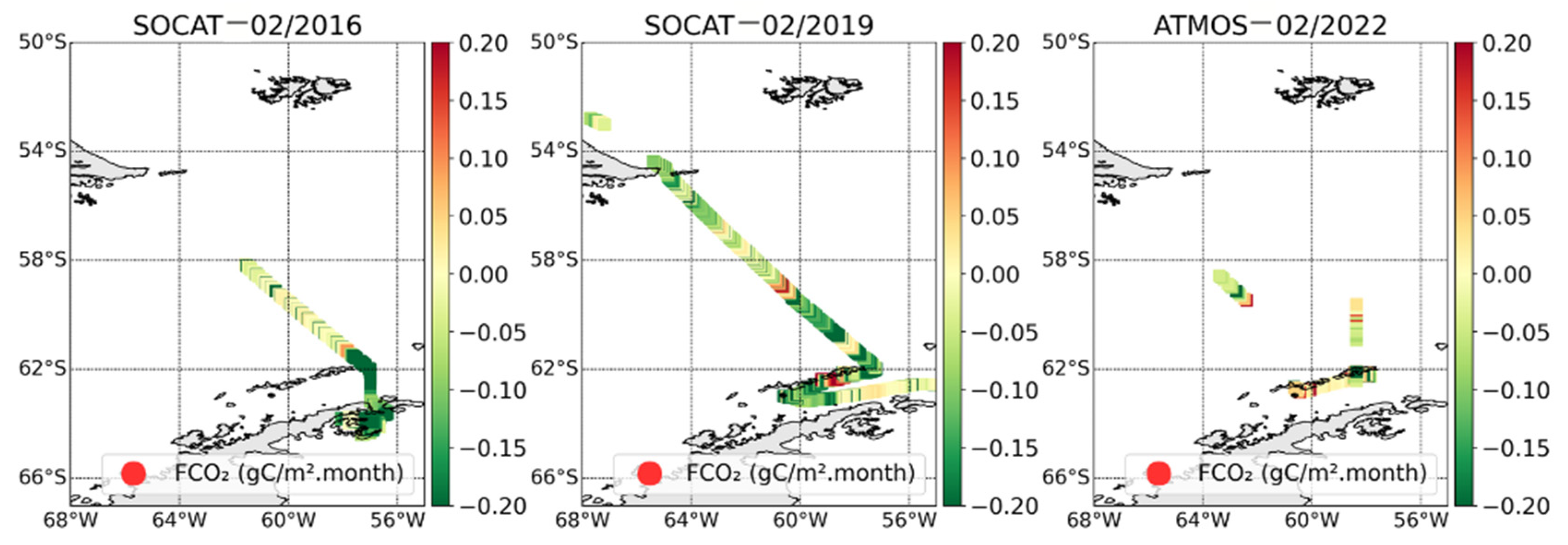Spatio-Temporal Variability in CO2 Fluxes in the Atlantic Sector of the Southern Ocean
Abstract
:1. Introduction
2. Materials and Methods
2.1. Study Area
2.2. In Situ Data
2.3. Satellite and Reanalysis Data Set
2.4. Eddy Covariance Method
2.5. Artificial Neural Network to Estimate pCO2sea
2.6. Bulk Parameterization
2.7. CO2 Flux Variability Analysis
3. Results
3.1. CO2 Flux Variability in February
3.2. FCO2 Calculated with an Artificial Neural Network
3.3. Variability in CO2 Flux
4. Final Remarks and Conclusions
Author Contributions
Funding
Institutional Review Board Statement
Informed Consent Statement
Data Availability Statement
Acknowledgments
Conflicts of Interest
References
- Landschützer, P.; Gruber, N.; Bakker, D.C.E.; Schuster, U.; Nakaoka, S.; Payne, M.R.; Sasse, T.P.; Zeng, J. A neural network-based estimate of the seasonal to inter-annual variability of the Atlantic Ocean carbon sink. Biogeosciences 2013, 10, 7793–7815. [Google Scholar] [CrossRef]
- Silva, L.A.; de Andrade, J.B.; Lopes, W.A.; Carvalho, L.S.; Pereira, P.A.P. Solubility and reactivity of gases. Quim. Nova 2017, 40, 824–832. [Google Scholar] [CrossRef]
- Rodrigues, C.C.F.; Santini, M.F.; Lima, L.S.; Sutil, U.A.; Carvalho, J.T.; Cabrera, M.J.; Rosa, E.B.; Burns, J.W.; Pezzi, L.P. Ocean-atmosphere turbulent CO2 fluxes at Drake Passage and Bransfield Strait. An. Acad. Bras. Ciências 2023, 95, e20220652. [Google Scholar] [CrossRef] [PubMed]
- Santini, M.F.; Souza, R.B.; Wainer, I.; Muelbert, M.M. Temporal analysis of water masses and sea ice formation rate west of the Antarctic Peninsula in 2008 estimated from southern elephant seals’ SRDL–CTD data. Deep Sea Res. Part II Top. Stud. Oceanogr. 2018, 149, 58–69. [Google Scholar] [CrossRef]
- Bremer, U.F.; Campos, L.d.S.; Evangelista, H.; Garcia, C.A.E.; Goldemberg, J.; Mata, M.M.; Paulsen, L.; Simões, J.C. Antártica e as Mudanças Globais: Um Desafio para a Humanidade; Blucher: São Paulo, Brazil, 2011; E-book; ISBN 9788521216087. Available online: https://app.minhabiblioteca.com.br/books/9788521216087 (accessed on 20 March 2023).
- Landschützer, P.; Gruber, N.; Haumann, F.A.; Rödenbeck, C.; Bakker, D.C.E.; van Heuven, S.; Hoppema, M.; Metzl, N.; Sweeney, C.; Takahashi, T.; et al. The reinvigoration of the Southern Ocean carbon sink. Science 2015, 349, 6253. [Google Scholar] [CrossRef]
- Sutton, A.J.; Williams, N.L.; Tilbrook, B. Constraining Southern Ocean CO2 Flux Uncertainty Using Uncrewed Surface Vehicle Observations. Geophys. Res. Lett. 2021, 48, e2020GL091748. [Google Scholar] [CrossRef]
- Pezzi, L.P.; de Souza, R.B.; Santini, M.F.; Miller, A.J.; Carvalho, J.T.; Parise, C.K.; Quadro, M.F.; Rosa, E.B.; Justino, F.; Sutil, U.A.; et al. Oceanic eddy-induced modifications to air–sea heat and CO2 fluxes in the Brazil-Malvinas Confluence. Sci. Rep. 2021, 11, 10648. [Google Scholar] [CrossRef]
- Heinze, C.; Meyer, S.; Goris, N.; Anderson, L.; Steinfeldt, R.; Chang, N.; Le Quéré, C.; Bakker, D.C.E. The ocean carbon sink—Impacts, vulnerabilities and challenges. Earth Syst. Dynam. 2015, 6, 327–358. [Google Scholar] [CrossRef]
- Brown, M.S.; Munro, D.R.; Feehan, C.J.; Sweeney, C.; Ducklow, H.W.; Schofield, O.M. Enhanced oceanic CO2 uptake along the rapidly changing West Antarctic Peninsula. Nat. Clim. Change 2019, 9, 678–683. [Google Scholar] [CrossRef]
- Avelina, R.; da Cunha, L.C.; Farias, C.d.O.; Hamacher, C.; Kerr, R.; Mata, M.M. Contrasting dissolved organic carbon concentrations in the Bransfield Strait, northern Antarctic Peninsula: Insights into ENOS and SAM effects. J. Mar. Syst. 2020, 212, 103457. [Google Scholar] [CrossRef]
- Pezzi, L.P.; de Souza, R.B.; Quadro, M.F. Uma Revisão dos Processos de Interação Oceano-Atmosfera em Regiões de Intenso Gradiente Termal do Oceano Atlântico Sul Baseada em Dados Observacionais. Rev. Bras. Meteorol. 2016, 31, 428–453. [Google Scholar] [CrossRef]
- Santini, M.F.; Souza, R.B.; Pezzi, L.P.; Swart, S. Observations of air-sea heat fluxes in the Southwestern Atlantic under high frequency ocean and atmospheric perturbations. Q. J. R. Meteorol. Soc. 2020, 146, 4226–4251. [Google Scholar] [CrossRef]
- Hackerott, J.A.; Pezzi, L.P.; Paskyabi, M.B.; Oliveira, A.P.; Reuder, J.; De Souza, R.B.; De Camargo, R. The role of roughness and stability on the momentum flux in the marine atmospheric surface layer: A study on the southwestern Atlantic Ocean. J. Geophys. Res. Atmos. 2018, 123, 3914–3932. [Google Scholar] [CrossRef]
- Parkinson, C.L.; Cavalieri, D.J. Antarctic sea ice variability and trends, 1979–2010. Cryosphere 2012, 6, 871–880. [Google Scholar] [CrossRef]
- Parkinson, C.L. 40–y record reveals gradual Antarctic sea ice increases followed by decreases at rates far exceeding the rates seen in the Arctic. Proc. Natl. Acad. Sci. USA 2019, 116, 14414–14423. [Google Scholar] [CrossRef]
- Lovenduski, N.S.; Gruber, N.; Doney, S.C. Toward a mechanistic understanding of the decadal trends in the Southern Ocean carbon sink. Glob. Biogeochem. Cycles 2008, 22, GB3016. [Google Scholar] [CrossRef]
- Thompson, D.W.J.; Wallace, J.M. Annular Modes in the Extratropical Circulation. Part I: Month-to-month variability*. J. Clim. 2000, 13, 1000–1016. [Google Scholar] [CrossRef]
- Fogt, R.L.; Marshall, G.J. The Southern Annular Mode: Variability, trends, and climate impacts across the southern hemisphere. Wires Clim. Change 2020, 11, e652. [Google Scholar] [CrossRef]
- Schofield, O.; Brown, M.; Kohut, J.; Nardelli, S.; Saba, G.; Waite, N.; Ducklow, H. Changes in the upper ocean mixed layer and phytoplankton productivity along the West Antarctic Peninsula. Philos. Trans. R. Soc. A Math. Phys. Eng. Sci. 2018, 376, 20170173. [Google Scholar] [CrossRef]
- Keppler, L.; Landschützer, P. Regional wind variability modulates the Southern Ocean carbon sink. Sci. Rep. 2019, 9, 7384. [Google Scholar] [CrossRef]
- Nevison, C.D.; Munro, D.R.; Lovenduski, N.S.; Keeling, R.F.; Manizza, M.; Morgan, E.J.; Rödenbeck, C. Southern Annular Mode Influence on Wintertime Ventilation of the Southern Ocean Detected in Atmospheric O2 and CO2 Measurements. Geophys. Res. Lett. 2020, 47, e2019GL085667. [Google Scholar] [CrossRef]
- Costa, R.R.; Mendes, C.R.B.; Tavano, V.M.; Dotto, T.S.; Kerr, R.; Monteiro, T.; Odebrecht, C.; Secchi, E.R. Dynamics of an intense diatom bloom in the Northern Antarctic Peninsula, February 2016. Limnol. Oceanogr. 2020, 65, 2056–2075. [Google Scholar] [CrossRef]
- Takahashi, T.; Sutherland, S.C.; Wanninkhof, R.; Sweeney, C.; Feely, R.A.; Chipman, D.W.; Hales, B.; Friederich, G.; Chavez, F.; Sabine, C. Climatological mean and decadal change in surface ocean pCO2, and net sea–air CO2 flux over the global oceans. Deep Sea Res. Part II Top. Stud. Oceanogr. 2009, 56, 554–577. [Google Scholar] [CrossRef]
- Sabine, C.L.; Hankin, S.; Koyuk, H.; Bakker, D.C.E.; Pfeil, B.; Olsen, A.; Metzl, N.; Kozyr, A.; Fassbender, A.; Manke, A.; et al. Surface Ocean CO2 Atlas (SOCAT) gridded data products. Earth Syst. Sci. Data 2013, 5, 145–153. [Google Scholar] [CrossRef]
- Bakker, D.C.E.; Pfeil, B.; Landa, C.S.; Metzl, N.; O’Brien, K.M.; Olsen, A.; Smith, K.; Cosca, C.; Harasawa, S.; Jones, S.D.; et al. A multi-decade record of high quality fCO2 data in version 3 of the Surface Ocean CO2 Atlas (SOCAT). Earth Syst. Sci. Data 2016, 8, 383–413. [Google Scholar] [CrossRef]
- Meijers, A.J.S. The Southern Ocean in the Phase-5 Coupled Model Intercomparison Project. Philos. Trans. R. Soc. Lond. Ser. A Math. Phys. Eng. Sci. 2014, 372, 20130296. [Google Scholar] [CrossRef]
- Monteiro, T.; Kerr, R.; Machado, E.d.C. Seasonal variability of net sea-air CO2 fluxes in a coastal region of the northern Antarctic Peninsula. Sci. Rep. 2020, 10, 14875. [Google Scholar] [CrossRef]
- Zeng, J.; Nojiri, Y.; Landschützer, P.; Telszewski, M.; Nakaoka, S. A Global Surface Ocean fCO2 Climatology Based on a Feed-Forward Neural Network. J. Atmos. Ocean. Technol. 2014, 31, 1838–1849. [Google Scholar] [CrossRef]
- Moussa, H.; Benallal, M.A.; Goyet, C.; Lefèvre, N. Satellite-derived CO2 fugacity in surface seawater of the tropical Atlantic Ocean using a feedforward neural network. Int. J. Remote Sens. 2016, 37, 580–598. [Google Scholar] [CrossRef]
- Orsi, A.H.; Whitworth, T.; Nowlin Junior, W.D. On the meridional extent and fronts of the Antarctic Circumpolar Current. Deep-Sea Res. 1995, 42, 641–673. [Google Scholar] [CrossRef]
- Klinck, J.M.; Nowlin, W.D., Jr. Antarctic Circumpolar Current. In Encyclopedia of Ocean Science, 1st ed.; Academic Press: San Diego, CA, USA, 2001; pp. 151–159. [Google Scholar]
- Barker, P.F.; Filippelli, G.M.; Florindo, F.; Martin, E.E. Onset and role of the Antarctic Circumpolar Current. Deep-Sea Res. Part II Topical Stud. Oceanogr. 2007, 54, 2388–2398. [Google Scholar] [CrossRef]
- Marshall, J.; Speer, K. Closure of the meridional overturning circulation through Southern Ocean upwelling. Nat. Geosci. 2012, 5, 171–180. [Google Scholar] [CrossRef]
- Sallée, J.B.; Speer, K.; Rintoul, S.; Wijffels, S. Southern Ocean thermocline ventilation. J. Phys. Oceanogr. 2010, 40, 509–529. [Google Scholar] [CrossRef]
- Ohshima, K.I.; Fukamachi, Y.; Williams, G.D.; Nihashi, S.; Roquet, F.; Kitade, Y.; Tamura, T.; Hirano, D.; Herraiz-Borreguero, L.; Field, I.; et al. Antarctic bottom water production by intense sea-ice formation in the Cape Darnley Polynya. Nat. Geosci. 2013, 6, 235–240. [Google Scholar] [CrossRef]
- Wallace, J.M.; Hobbs, P.V. Atmospheric Science: An Introductory Survey, 2nd ed.; Academic Press: London, UK, 2006; p. 483. [Google Scholar]
- Voermans, J.J.; Babanin, A.V.; Kirezci, C.; Carvalho, J.T.; Santini, M.F.; Pavani, B.F.; Pezzi, L.P. Wave Anomaly Detection in Wave Measurements. J. Atmos. Ocean. Technol. 2021, 38, 525–536. [Google Scholar] [CrossRef]
- Carvalho, G.T.; Pezzi, L.P. Data from the Micrometeorological Tower of the Antarctic Modeling Observation System (ATMOS) Project of the 40th Brazilian Antarctic Operation (OPERANTAR XL) to Calculate the CO2 flux (FCO2) [Data Set]. Zenodo. 2024. Available online: https://zenodo.org/records/10871385 (accessed on 10 May 2024).
- Miller, S.D.; Marandino, C.; Saltzman, E.S. Ship-based measurement of air–sea CO2 exchange by eddy covariance. J. Geophys. Res. 2010, 115, D02304. [Google Scholar] [CrossRef]
- Mcgillis, W.R.; Edson, J.B.; Fairall, C.W. Direct covariance air-sea CO2 fluxes. J. Geophys. Res. 2001, 106, 16729–16745. [Google Scholar] [CrossRef]
- Foken, T. Micrometeorology; Springer-Verlag: Berlin, Germany, 2008; 308p. [Google Scholar]
- Miller, S.D.; Hristov, T.S.; Edson, J.B.; Friehe, C.A. Platform motion effects on measurements of turbulence and air-sea exchange over the open ocean. J. Atmos. Ocean. Technol. 2008, 25, 1683–1694. [Google Scholar] [CrossRef]
- Géron, A. Hands-On Machine Learning with Scikit-Learn and TensorFlow: Concepts, Tools, and Techniques to Build Intelligent Systems; O’Reilly Media: Sebastopol, CA, USA, 2017. [Google Scholar]
- Chollet, F. Deep Learning with Python; Manning Publications Co.: Shelter Island, NY, USA, 2018; 361p. [Google Scholar]
- Farias, E.G.G.; Nobre, P.; Lorenzzetti, J.A.; de Almeida, R.A.F.; Júnior, L.C.I. Variability of air-sea CO2 fluxes and dissolved inorganic carbon distribution in the Atlantic basin: A coupled model analysis. Int. J. Geosci. 2013, 4, 249–258. [Google Scholar] [CrossRef]
- Ito, R.G.; Garcia, C.A.E.; Tavano, V.M. Net sea-air CO2 fluxes and modelled pCO2 in the southwestern subtropical Atlantic continental shelf during spring 2010 and summer 2011. Cont. Shelf Res. 2016, 119, 68–84. [Google Scholar] [CrossRef]
- Weiss, R.F. Carbon dioxide in water and seawater: The solubility of a non-ideal gas. Mar. Chem. 1974, 2, 203–215. [Google Scholar] [CrossRef]
- Sweeney, M.O.; Ruetz, L.L.; Belk, P.; Mullen, T.J.; Johnson, J.W.; Sheldon, T.B. Pacing-induced short-long-short sequences at the onset of ventricular tachyarrhythmias. J. Am. Coll. Cardiol. 2007, 50, 614–622. [Google Scholar] [CrossRef] [PubMed]
- Franke, R. Scattered Data Interpolation: Test of Some Methods. Math. Comput. 1982, 33, 181–200. [Google Scholar]
- Dejong, H.B.; Dunbar, R.B. Air-sea CO2 exchange in the Ross Sea, Antarctica. J. Geophys. Res. Ocean. 2017, 122, 8167–8181. [Google Scholar] [CrossRef]
- Ducklow, H.W.; Fraser, W.R.; Meredith, M.P.; Stammerjohn, S.E.; Doney, S.C.; Martinson, D.G.; Sailley, S.F.; Schofield, O.M.; Steinberg, D.K.; Venables, H.J.; et al. West Antarctic Peninsula: An ice-dependent coastal marine ecosystem in transition. Oceanography 2013, 26, 190–203. [Google Scholar] [CrossRef]
- Viana, D.; De, L.; Oliveira, J.E.L.; Hazin, F.H.V.; Souza, M.A.C. Marine sciences: From the world’s oceans to northeast Brazil. Via Des. Publicações 2021, 512. Available online: https://www.marinha.mil.br/secirm/sites/www.marinha.mil.br.secirm/files/publicacoes/ppgmar/CienciasdoMarVol2.pdf (accessed on 10 May 2024).
- Gloege, L.; McKinley, G.A.; Landschützer, P.; Fay, A.R.; Frölicher, T.L.; Fyfe, J.C.; Ilyina, T.; Jones, S.; Lovenduski, N.S.; Rödenbeck, C.; et al. Quantifying errors in observationally based estimates of ocean carbon sink variability. Glob. Biogeochem. Cycles 2021, 35, e2020GB006788. [Google Scholar] [CrossRef]
- Arrigo, K.R.; Van Dijken, G.L. Interannual variation in air-sea CO2 flux in the Ross Sea, Antarctica: A model analysis. J. Geophys. Res. 2007, 112, C03020. [Google Scholar] [CrossRef]
- Le Quéré, C.; Rödenbeck, C.; Buitenhuis, E.T.; Conway, T.J.; Langenfelds, R.; Gomez, A.; Labuschagne, C.; Ramonet, M.; Nakazawa, T.; Metzl, N.; et al. Saturation of the Southern Ocean CO2 sink due to recent climate change. Science 2007, 316, 1735–1738. [Google Scholar] [CrossRef]
- Tomczak, M.; Godfrey, J.S. Regional Oceanography: An Introduction; Pergamon: New York, NY, USA, 1994. [Google Scholar]
- Shetye, S.; Jena, B.; Mohan, R. Dynamics of sea-ice biogeochemistry in coastal Antarctica during the transition from summer to winter. Geosci. Front. 2017, 8, 507–516. [Google Scholar] [CrossRef]
- Nomura, D.; Yoshikawa-Inoue, H.; Toyota, T. The effect of sea-ice growth on air–sea CO2 flux in a tank experiment. Tellus B 2006, 58, 418–426. [Google Scholar] [CrossRef]
- Wadhams, P. Ice in the Ocean; Gordon and Breach Science Publishers: Amsterdam, The Netherlands, 2000; p. 351. [Google Scholar]
- Stammerjohn, S.E.; Martinson, D.G.; Smith, R.C.; Iannuzzi, R.A. Sea ice in the western Antarctic Peninsula region: Spatiotemporal variability from ecological and climate change perspectives. Deep Sea Res. 2008, 55, 2041–2058. [Google Scholar] [CrossRef]
- Friedlingstein, P.; Cox, P.; Betts, R.; Bopp, L.; von Bloh, W.; Brovkin, V.; Cadule, P.; Doney, S.; Eby, M.; Fung, I.; et al. Climate–carbon cycle feedback analysis: Results from the C4MIP model intercomparison. J. Clim. 2006, 19, 3337–3353. [Google Scholar] [CrossRef]
- Roy, T.; Bopp, L.; Gehlen, M.; Schneider, B.; Cadule, P.; Frölicher, T.L.; Segschneider, J.; Tjiputra, J.; Heinze, C.; Joos, F. Regional impacts of climate change and atmospheric CO2 on future ocean carbon uptake: A multimodel linear feedback analysis. J. Climate 2011, 24, 2300–2318. [Google Scholar] [CrossRef]
- Arora, T.; Broglia, E.; Thomas, G.N.; Taheri, S. Associations between specific technologies and adolescent sleep quantity, sleep quality, and parasomnias. Sleep Med. 2014, 15, 240–247. [Google Scholar] [CrossRef]
- Steinacher, M.; Joos, F. Transient Earth system responses to cumulative carbon dioxide emissions: Linearities, uncertainties, and probabilities in an observation-constrained model ensemble. Biogeosciences 2016, 13, 1071–1103. [Google Scholar] [CrossRef]
- Zickfeld, K.; Eby, M.; Weaver, A.J.; Alexander, K.; Crespin, E.; Edwards, N.R.; Eliseev, A.V.; Feulner, G.; Fichefet, T.; Forest, C.E.; et al. Long-term climate change commitment and reversibility: An EMIC intercomparison. J. Clim. 2013, 26, 5782–5809. [Google Scholar] [CrossRef]
- Di Martino, M.L. Re-thinking the Brazilian migration: The agency of highly educated Brazilian women. Rev. Bras. Ciênc. Soc. 2024, 39. [Google Scholar] [CrossRef]
- Pickard, G.L.; Emery, W.J. Descriptive Physical Oceanography; Pergamon: New York, NY, USA, 1990. [Google Scholar]
- Baines, P.G. Coastal and regional currents of Antarctica. In Encyclopaedia of the Antarctic; Riffenburgh, B., Ed.; Routledge: London, UK, 2006. [Google Scholar]
- Cai, W.J.; Cowan, T. Trends in Southern Hemisphere circulation in IPCC AR4 models over 1950–99: Ozone-depletion vs. greenhouse forcing. J. Clim. 2007, 20, 681–693. [Google Scholar] [CrossRef]
- IPCC—Intergovernmental Panel on Climate Change, Working Group I Contribution to the Fifth Assessment Report, Climate Change 2013—The Physical Science Basis. Available online: https://www.ipcc.ch/report/ar5/wg1/ (accessed on 10 May 2024).
- Pezzi, L.P.; Souza, R.B.; Acevedo, O.; Wainer, I.; Mata, M.M.; Garcia, C.A.E.; Camargo, R. Multiyear measurements of the oceanic and atmospheric boundary layers at the Brazil-Malvinas confluence region. J. Geophys. Res. Atmos. 2009, 114, D19106. [Google Scholar] [CrossRef]
- Gupta, A.; England, M.H. Coupled ocean–atmosphere–ice response to variations in the Southern Annular Mode. J. Clim. 2006, 19, 4457–4486. [Google Scholar] [CrossRef]
- Meredith, M.P.; Stammerjohn, S.E.; Venables, H.J.; Ducklow, H.W.; Martinson, D.G.; Iannuzzi, R.A.; Leng, M.J.; Van Wessem, J.M.; Reijmer, C.H.; Barrand, N.E. Changing distributions of sea ice melt and meteoric water west of the Antarctic Peninsula. Deep Sea Res. 2017, 139, 40–57. [Google Scholar] [CrossRef]
- Carvalho, G.T.; Mejia, C. Artificial Neural Network (ANN) to estimate pCO2sea. (Version 1.1.0) [Software]. (RNApCO2sea-Carvalho). Zenodo. 2024. Available online: https://zenodo.org/records/10854860 (accessed on 10 May 2024).







| Sensor | Model | Manufacturer | Variables Sampled |
|---|---|---|---|
| Integrated CO2/H2O open-path gas analyzer and 3D sonic anemometer | IRGASON | Campbell Scientific/Logan/Utah/EUA | CO2 density and H2O density 3D wind components, air temperature, and air pressure |
| Multi axis inertial sensing system | Motion Pack II | Systron Donner Inertial/Concord/California | 3D accelerations and 3D angular Velocities |
| GPS | GPS16X-HVS | Garmin/Taiwan, Province of China | Position |
| Infrared gas analyzer | LI-850 | Li-cor Biogeosciences/Lincoln/ United States | CO2 concentrations in water |
| Data Source | Spatial Resolution | Date | Variable |
|---|---|---|---|
| OCO-2 | 0.5° × 0.625° | 2015–2022 | xCO2air |
| AIRS/Aqua | 2° × 2.5° | 2012–2014 | xCO2air |
| AIRS + AMSU | 2° × 2.5° | 2003–2011 | xCO2air |
| Multi Observation Global Ocean ARMOR3D | 0.25° × 0.25° | 2003–2022 | SST and SSS |
| MERRA-2 | 0.5° × 0.625° | 2003–2022 | SLP, Tair, and Wind speed |
| PISCES biogeochemical model | 0.25° × 0.25° | 2003–2022 | Chl |
Disclaimer/Publisher’s Note: The statements, opinions and data contained in all publications are solely those of the individual author(s) and contributor(s) and not of MDPI and/or the editor(s). MDPI and/or the editor(s) disclaim responsibility for any injury to people or property resulting from any ideas, methods, instructions or products referred to in the content. |
© 2025 by the authors. Licensee MDPI, Basel, Switzerland. This article is an open access article distributed under the terms and conditions of the Creative Commons Attribution (CC BY) license (https://creativecommons.org/licenses/by/4.0/).
Share and Cite
de Carvalho, G.T.; Pezzi, L.P.; Lefèvre, N.; Rodrigues, C.C.F.; Santini, M.F.; Mejia, C. Spatio-Temporal Variability in CO2 Fluxes in the Atlantic Sector of the Southern Ocean. Atmosphere 2025, 16, 319. https://doi.org/10.3390/atmos16030319
de Carvalho GT, Pezzi LP, Lefèvre N, Rodrigues CCF, Santini MF, Mejia C. Spatio-Temporal Variability in CO2 Fluxes in the Atlantic Sector of the Southern Ocean. Atmosphere. 2025; 16(3):319. https://doi.org/10.3390/atmos16030319
Chicago/Turabian Stylede Carvalho, Gabrielle Tavares, Luciano Ponzi Pezzi, Nathalie Lefèvre, Celina Cândida Ferreira Rodrigues, Marcelo Freitas Santini, and Carlos Mejia. 2025. "Spatio-Temporal Variability in CO2 Fluxes in the Atlantic Sector of the Southern Ocean" Atmosphere 16, no. 3: 319. https://doi.org/10.3390/atmos16030319
APA Stylede Carvalho, G. T., Pezzi, L. P., Lefèvre, N., Rodrigues, C. C. F., Santini, M. F., & Mejia, C. (2025). Spatio-Temporal Variability in CO2 Fluxes in the Atlantic Sector of the Southern Ocean. Atmosphere, 16(3), 319. https://doi.org/10.3390/atmos16030319








